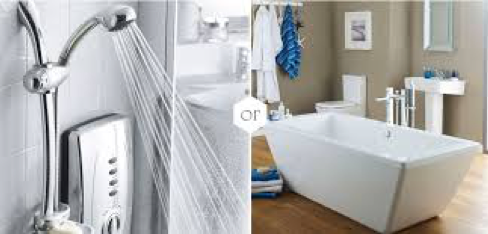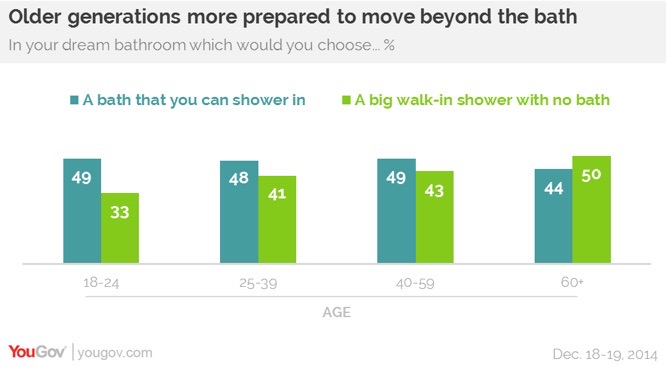
I’ve been toying with the idea of removing the bath and having a shower instead and thought to do some research to see what others think. I am aware that there is a perception that ‘everyone’ in Britain demands a bath, but quite clearly that is exactly right, it is a perception. It is far harder is to discover whether the bath is installed but unused.
“An average bath uses 80 litres of water. An average shower uses 62 litres of water. A power shower lasting 8 minutes uses 136 litres. “
First, we have an assumption that a bath uses more water. I am told by many sites that a bath is 80 litres, but not what the variance is (so I have no idea of the distribution), I even found it difficult to see what 80 litres of bath looks like, so I estimated in our bath and find that an 80 litre bath is about 10cm deep before you get in. Which suggests that if you are 60 litres2 and the bath is 100 litres, you’ll just hit the overflow (160-175 litres, depending on the bath1) at total immersion. The 80 litre figure is widely quoted but with no original source.
An internal cold water tank means low pressure system, so 0.5 bar pressure represents 10-12 l/m. A mains fed system could easily be at 2 bar and is not likely to exceed 3 bar, which suggests 15-25 l/min. Of course you can restrict the flow by not fully opening your incoming valve.
Relevant here is the rate of delivery of water for a shower, easily measured with tap, clock and bucket. I was expecting 8 litres a minute and found we have 30 at the sink and 11 at the shower (so I did the measuring again3). Mains fed system, 13-5mm pipe to the shower; this is consistent with the inset text.
Now I have come to realise that, having lived in China where there is very rarely a bath, I actually came to prefer showers most of the time. I take advantage of access to baths in hotels, considering that in such places the expectation is that I will use a bath and so in some sense it is already paid for. Indeed, that is my current habit; when in a hotel and given enough time, I’ll have a full, hot bath and soak as comfort lasts. So those baths are 100-120 litres4 (and I can do sums reliably). A shower, on the other hand is 2-6 minutes, depending more on the pressure to do the next thing, though I’ll agree I stay the longer times when my hands went numb out running or if I ended up extra muddy. So typical usage by me is 20-70 litres. Bathing in China is done at the spa, of which there are many. See my experience, 2008.
Using the widely quoted numbers, an 80 litre bath is equivalent to a 5-7 minute shower, assuming 12-15 litres/minute. But if you want to know your own circumstances, you need to find your own measurements for flow rate, bath depth and shower times. My showers are very much smaller than my baths, and what I call a long shower is still around half of what I call a proper bath.
None of that measurement deals with what, for many people is a significant issue: Does having a bath or not affect the value of your house? There are only muddy answers to this. You.gov did a survey, but yet again the questions asked spoiled the answers by virtue of the implied assumptions. “The bath question was badly flawed. I am very much a bath person but would like a separate shower too. That was not an option. You could only choose between having no bath or a bath which you could also shower in. Both bad options.” “Agree with this. I answered the question as "don't know". I have both a bath and a separate shower, and this is what I want. The question should be phrased as if forced to choose, would you prefer a bath without a shower, or a shower without a bath?”
So the survey results do not reflect what we might want to know: results for this restricted choice are shown here.

I repeat that this does not tell us about houses without a bath, nor about houses with more than one such facility. It fails to tell us about the difference between wants, needs and perceptions. Many respondents in the streams I found to read were American and they reflected similar perceptions, mainly that there are so many people ‘out there’ who will reject your house for sale because it has no bathtub, that this will affect the value of your house. Not true, it affects those who will like your house, so it changes the size of the pool from which your buyer will come. So perhaps it makes the estate agent / realtor work harder, but I think that in the modern age the buyer is researching through a screen and will eliminate this preference or not before including the agent (for otherwise at least one party is wasting time). I read of many arguing that families with small children ‘need’ a bath, followed by sensible people advocating (i) a tub in the sink, (b) a tub in the shower, (c) a shower with a bench. The same applied to the dog-in-the-bath argument, where (c) won hands down as a preferred solution. Oh, and far too many people cited the only user of the bath being the dog.
Does it change the value of your house? Not in any measurable way. It does change who it is that will find your house attractive, which, I repeat, reduces the market, not the price. That in turn means that the compromise is going to be perceived as the solution. Which means that until you have a house with shower and tub, you won’t discover (i) how you feel (ii) if the bath is valued by your eventual purchaser – only that they, too feel the tub to be a required element of their image of a house.
It is entirely a different problem when you are short of space. We are. No, let’s be exact here, we perceive that we are, because we are used to 130m2 not the 65m2 we currently have. But the houses around us are of a similar size and generally have more people per house, so, while we think we could use the space better if we swapped bath for shower and some spare floor for storage, our neighbours all think otherwise. Which consequentially means that losing the bath in our case would severely restrict the market and therefore would entail a loss of price, i.e value on selling. We have a bath and a shower, that is a bath with a shower attachment and curtain, etc, plus another room on a different floor with a single dedicated shower unit. The boss has taken baths twice in the year (but ducked this when in hotels, despite having said she wanted to enjoy the bath) and we have between us probably a dozen showers a week5. So our bath is currently used as the space for putting washing, both before and after6.
The comments that follow the property value report have, I think, the right of it: The perception is that so very many people think a bath is a must-have element of a house that the decision to keep or lose a bath is taken only on the basis of need for space. Once a house is big enough for a bath and a shower, everyone is happy.
Our bath remains unused and unwanted until the house sells. We’re not even using it as a second shower.
DJS 20170424
top pic from Google images.
This may be website page 500
http://www.harwoodandassociates.co.uk/faqs/how-much-water-does-a-bath-use/
http://www.harwoodandassociates.co.uk/faqs/guidance-on-flow-rates-for-taps-showers-and-baths/
https://yougov.co.uk/news/2014/12/30/are-you-bath-person-or-shower-person-what-your-dre/
http://www.huffingtonpost.com/entry/baths-versus-showers_us_57f81387e4b0e655eab4530d
http://www.sixwise.com/newsletters/07/04/10/bath-or-shower-which-is-better-for-you-and-why.htm discusses which is good for you.
http://www.waterwise.org.uk/news.php/11/showers-vs.-baths-facts-figures-and-misconceptions no more numbers than I’d already found
http://www.slate.com/articles/double_x/doublex/2015/07/baths_are_better_than_showers_a_manifesto.html argues for baths.
http://www.telegraph.co.uk/news/health/7888165/Why-have-baths-disappeared-down-the-plughole.html Fay Weldon argues for the contemplative bath. I get the same result (better, I think) from the run before the shower.
http://www.propertyinvestmentproject.co.uk/blog/i-have-a-small-bathroom-shower-vs-bath/ sensibly addressing the property market aspect
1 A full bath is 160 litres [42 gallons, 1700x700 standard BS6700 overall size, 180 litres at the overflow point and the British Standard says 100 litres is a typical volume, not the 80 so often quoted. 100 litres in this standard bath gives 18cm water depth]. A standard bath will be 40-42ºC. Source indirect because the BS is (i) £147 (ii) apparently somehow discontinued.
2 Apparently we displace 0.75 litres per kg, so 60-80 kg represents 45-60 litres. Source Harwoods. So a 100 litre bath before you get in is about 10cm short of the overflow mark, and unless you’re outside the weight range I used, putting more water is soon wasted, down the overflow.
3 8 pints in 9 secs at sink is 0.5 litres/sec, 30 litres/minute; 23-4 secs in the shower, 11 to 12 litres/minute.
4 Harwoods again: a 1700x700 standard bath footprint is 175 litres at overflow. A 1800x800 bath is 250 litres. Looking at a bath site, a 1500 length is 152 litres, 1600 165 and 1700 174 (these were the ‘eco’ models). Big baths pass 300 litres. The Quantum range on the same site gave number pairs (1500, 198), (1600, 213), (1700, 228), (1800, 260) for the 700 nominal width. My impression was that those people buying baths are going for large volume, which means to me that they’re using large amounts of water when they bathe.
5 For those who have had suggested that showering with a friend is cheaper, I disagree; those showers take a lot longer than two separate uses. I suppose it depends how you rate as ‘friend’ for showering purposes. All my such friends have been spouse, too.
6 The so-called airer sits in the bath, as does the washing basket. If we stay any length of time I will arrange hanging space over the bath and we will set that room’s radiator to run hot and the others off, so that drying occurs on the frequent wet days that Manchester provides. It’s not the bath, it’s the lost space above the bath. I have already used underneath the bath as storage – amazing how much will fit under there, but more amazing is the multiple possession of cleaners we only need one of, or only one of each. And at least 20 spare toilet rolls.... Long supply chain? Poor replenishment cycle?